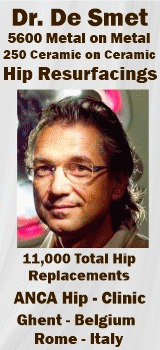Gantz Approach by Dr. Brooks
Hi Pat,
You asked about the Ganz approach, which is also known as "surgical dislocation" of the hip for resurfacing.
This was described way back in 2001 by Prof. Reinhold Ganz in Berne, Switzerland. Resurfacing was being done in those days, although not so much by him, and he used it for all kinds of hip surgery from debridement to revision total hips. The key factor is that it is designed to preserve the blood supply to the femoral head. That is irrelevant in hip replacement because the femoral head is getting cut off anyway. In joint preservation procedures like FAI operations, labral repairs, removal of loose bodies etc and in hip resurfacing, it is important that the femoral head blood supply is respected.
Dr Ganz's major contributions have been his descriptions of the blood supply to the femoral head, and of femoroacetabular impingement (FAI) in the development of hip arthritis.
There is little question that the posterior approach routinely damages the blood supply to the femoral head. But there is also little question that this approach yields excellent outcomes in hip resurfacing, and is done by most US surgeons, about 80%. The pioneering surgeons McMinn and Treacy both use the posterior approach.
The early post-op femoral neck fracture risk is 1-2% in men, and 3-4% in women, and since these are likely "fatigue" fractures or accumulated microstresses, I would expect that blood supply is important in preventing them.
Proponents of the anterior approaches, myself included, like to preserve the blood supply to the femoral head. These approaches include the anterolateral (like me), the direct anterior, and Ganz. In that both the femoral neck and the acetabulum face anteriorly, and the common FAI lesions on the femoral neck are anterior, it makes sense to go in that way. If you want to see someone at their front door, why go in the back? Having said this, remember that experienced posterior surgeons have no trouble seeing everything, but a less experienced surgeon would struggle.
In all the anterior approaches, to get to the front of the hip you need to get the abductor muscles out of the way. You can retract them, split them, or cut them, but they have to be moved.
Ganz cuts through the bone of the greater trochanter, where the abductors attach, moves the bone plus muscle out of the way, and gets in that way. On the way out, then, one has to reattach the bone using hardware: either screws or wires, and protect the bone until it heals by delaying weight-bearing. Of course, any time you cut a bone and put it together, there is a chance that it does not "knit" or heal, just like a fracture. This causes pain, broken or loose hardware, and probably more surgery to fix it.
In the anterolateral approach you can spread the muscles apart, peel them off the trochanter and reattach them, or cut them. It's better to spread them in the line of their fibers, not cut them. This is how I do it. The muscles heal side-to-side, held together, not apart, by contractions. The blood supply is preserved, and I have had only one fracture so far out of 1100+. Knock on wood.
Posterior surgeons, like McMinn and Treacy, and most others too, cut a number of small muscles, ("the short external rotators") and sometimes part or all of gluteus maximus, and repair them on the way out in an end-to-end manner. Where total hips have a tendency to dislocate posteriorly, resurfacing is so stable that it really isn't an issue.
We would view Ganz's approach as being un-necessarily complex, and adding the additional risks of non-healing trochanteric osteotomy or broken hardware to the procedure. If you're concerned with the blood supply, do another, less complex anterior type of approach.
There are indeed circumstances during revision total hip replacements where a trochanteric osteotomy is useful, e.g. for getting out old stems and cement, and then I do it. The method Ganz described of "sliding" the trochanter and leaving it attached to the quadriceps below is how I do it, and hats off to him for that.
I have said this before, but I'll say it again: don't go and talk a surgeon into an approach that you like. He/she should do what they always do. Pick the surgeon. Resurfacing is a difficult operation, so your surgeon has to be comfortable with what they are doing. ANY approach, anterior, posterior, Ganz, etc can give the same excellent results in the hands of the experienced surgeon, using a good device, in an appropriate patient.
Regards,
Peter Brooks MD, FRCS(C)
Cleveland Clinic











